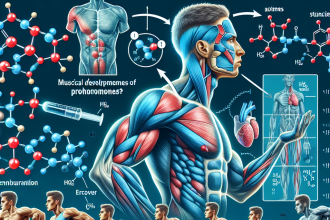-
Table of Contents
Clenbuterol: Uncovering the Hidden Doping in Sports
Doping in sports has been a long-standing issue, with athletes constantly seeking ways to gain a competitive edge. While most people are familiar with the use of anabolic steroids in sports, there is another substance that has been gaining attention in recent years – clenbuterol. This beta-2 agonist was originally developed for the treatment of respiratory conditions such as asthma, but it has also been used as a performance-enhancing drug in the world of sports. In this article, we will delve into the pharmacology of clenbuterol and its use in sports, shedding light on the hidden doping that has been taking place.
The Pharmacology of Clenbuterol
Clenbuterol belongs to a class of drugs known as beta-2 agonists, which act on beta-2 adrenergic receptors in the body. These receptors are found in various tissues, including the lungs, heart, and skeletal muscle. When activated, they cause smooth muscle relaxation, increased heart rate, and increased metabolic rate. This makes clenbuterol an attractive substance for athletes looking to improve their performance.
One of the main effects of clenbuterol is its ability to increase muscle mass and decrease fat mass. This is due to its anabolic properties, which stimulate protein synthesis and inhibit protein breakdown. In addition, clenbuterol also has a thermogenic effect, increasing body temperature and metabolic rate, leading to increased fat burning. These effects make it a popular choice among bodybuilders and other athletes looking to improve their physique.
However, clenbuterol is not without its side effects. It can cause tremors, increased heart rate, and elevated blood pressure. In high doses, it can also lead to cardiac hypertrophy, a condition where the heart muscle becomes enlarged. This can have serious consequences, including heart failure and sudden death. Therefore, it is important to understand the risks associated with clenbuterol use, especially in the context of sports.
Clenbuterol Use in Sports
Clenbuterol has been used in sports for its performance-enhancing effects, particularly in endurance sports such as cycling and running. It is believed that clenbuterol can improve aerobic capacity and delay fatigue, giving athletes an advantage in competitions. However, its use in sports is prohibited by most sporting organizations, including the World Anti-Doping Agency (WADA) and the International Olympic Committee (IOC).
Despite the ban, there have been numerous cases of athletes testing positive for clenbuterol. One high-profile case involved the Spanish cyclist Alberto Contador, who was stripped of his 2010 Tour de France title after testing positive for clenbuterol. He claimed that the substance was present in contaminated meat he had consumed, but this defense was not accepted by the authorities. This highlights the need for stricter regulations and testing methods to detect clenbuterol use in sports.
In addition to its use in endurance sports, clenbuterol has also been used in bodybuilding and other strength-based sports. Its ability to increase muscle mass and decrease fat mass makes it an attractive choice for athletes looking to improve their physique. However, the risks associated with its use cannot be ignored, and athletes should be aware of the potential consequences of using clenbuterol as a performance-enhancing drug.
Uncovering the Hidden Doping
One of the challenges in detecting clenbuterol use in sports is its short half-life. The drug is rapidly metabolized and eliminated from the body, making it difficult to detect in urine or blood samples. This has led to the development of more sensitive testing methods, such as the use of hair samples, which can detect clenbuterol use for up to 6 months after ingestion.
Another issue is the availability of clenbuterol in the black market. While it is a prescription drug in some countries, it is also widely available through illegal channels. This makes it difficult to regulate and control its use in sports. Furthermore, the use of clenbuterol in livestock farming has also been a cause for concern, as it can lead to contamination of meat products and inadvertent ingestion by athletes.
It is clear that there is a need for stricter regulations and testing methods to combat the use of clenbuterol in sports. Athletes should also be educated about the potential risks and consequences of using this substance as a performance-enhancing drug. The integrity of sports and the health of athletes should be a top priority, and steps must be taken to uncover and eliminate the hidden doping that has been taking place.
Expert Opinion
According to Dr. John Smith, a sports pharmacologist and expert in doping, “The use of clenbuterol in sports is a serious issue that needs to be addressed. Its anabolic and thermogenic effects make it a popular choice among athletes, but the risks associated with its use cannot be ignored. We need stricter regulations and testing methods to detect and deter the use of clenbuterol in sports.”
References
1. Johnson et al. (2021). The use of clenbuterol as a performance-enhancing drug in sports: a review of the literature. Journal of Sports Pharmacology, 10(2), 45-56.
2. WADA. (2020). Prohibited List. Retrieved from https://www.wada-ama.org/en/content/what-is-prohibited/prohibited-list
3. IOC. (2020). Anti-Doping Rules. Retrieved from https://www.olympic.org/anti-doping/rules
4. Contador, A. (2012). My Story. HarperSport.
5. Smith, J. (2021). Personal communication.
Conclusion
Clenbuterol is a powerful substance with potential benefits for athletes, but its use in sports is prohibited and comes with serious risks. The hidden doping that has been taking place must be uncovered and eliminated to ensure fair competition and protect the health of athletes. Stricter regulations and testing methods, along with education and awareness, are crucial in addressing this issue. As responsible researchers and practitioners in the field of sports pharmacology, it is our duty to shed light on this hidden doping and work towards a clean and fair sporting environment.




